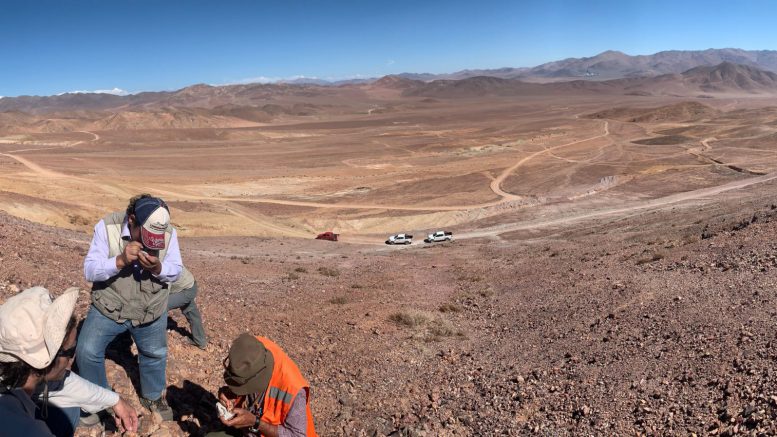Torq Resources (TSXV: TORQ) could be on the cusp of discovering not one, but two major copper-gold systems right under the noses of leading mining companies.
Working in northern Chile and in hand with one of the country’s most experienced exploration geologists, the company has already found significant mineralization on both sites but must keep drilling to assess their size.
Torq fulfils a long-held ambition for CEO, Shawn Wallace, and chief geological officer, Michael Henrichsen, to work in Chile, home to several of the biggest copper mines on the planet.
“It is a difficult place to get into as a junior,” explains Wallace. The country’s mineral tenure rules — under which claims can be held indefinitely — mean almost all prospective ground is already staked and tightly held.
Accessing potential targets means negotiating deals with wealthy families who have little motive to cede their land.
But by bringing in Waldo Cuadra, Torq’s country manager and a 40-year veteran of Chile’s exploration scene, who also played a part in discovering the El Morro copper-gold project, the company acquired a deep knowledge of Chile’s potential as well as good relations with all the key players.
Cuadra has brought along many of his long-time associates, including experts in land tenure, community relations as well as geology and geophysics.
“They’ve forgotten more about Chilean rocks than I’ll ever know,” Henrichsen says.
The team has hit the ground running with its first project — Margarita — an IOCG (iron-oxide-copper-gold) asset typical of Chile’s coastal mountain range, located close to Capstone Copper’s (TSX: CS) Mantoverde operation. With limited historic drilling and evidence of breccia and extensive alteration, the company’s bet was that they could find sulphide sources of the copper oxides visible at surface.
The wager came through in the thirteenth hole, the Falla 13 discovery, which included 90 metres of almost 1% copper and 0.84 gram gold per tonne almost from surface. Follow-up drilling has identified 800 metres of continuous mineralized body with gold levels that are unusually high for this kind of deposit.
Drilling of nearby targets, identified through geochemistry, has uncovered two more discoveries.
The latest results, published on Oct. 18, include a hole in a new parallel mineralized structure 200 metres west of the original Falla 13 discovery with one hole returning 42 metres of 1.1 gram gold per ton and 0.48% copper.
At the Cototuda target on the southwest of the property, a broad area of copper mineralization has taken the team by surprise with one hole intercepting 132 metres at 0.48% copper.
The hope is now that Torq could be on top of a cluster of mineralized bodies similar to those at Mantoverde and Santo Domingo (also owned by Capstone).
“To have this second discovery has been an incredibly important step and shows that the property has potential for different bodies,” Henrichsen explains.
The company now plans to start drilling to expand upon the latest discoveries at the Falla 13 area and at the Cototuda target to determine their scale. With additional drilling looking to build tons, the implications of these new discoveries have the potential to establish the project as an important emerging discovery within the Coastal Cordillera belt.
“The scale was already becoming attractive to mid-tier companies and now we’ve got this whole oxide story at the southern part of the project, which could be very important,” the geologist says.
Santa Cecilia
Torq’s bet on Chile does not end there. Following that initial success, Wallace and Henrichsen are now working on a second project high in the famous Maricunga belt, once known for gold mineralization but where some major porphyry deposits have been found in recent decades.
The Santa Cecilia project lies adjacent to two of the largest deposits — Caspiche and Cerro Casale — now owned by Barrick Gold (TSX: ABX) and Newmont Mining (NYSE: NEM) and which contain a measured and indicated resources totalling around 44 million oz. of gold and 11 billion lb. of copper.
But while they have been thoroughly drilled out and explored, quirks of the property system in Chile mean the adjacent Santa Cecilia has barely been touched.
“It’s like a time machine — while the whole porphyry story in the Maricunga evolved, almost no work was done on this property for 22 years,” explains Henrichsen.
Torq’s drilling began last March and results already suggest the company has struck gold again. Its second hole intersected 557 metres at 0.23% copper, 0.38 grams gold per ton and 56 parts per million molybdenum. So far, the grades encountered demonstrate that the company could be close to a high-grade core — similar to that at Caspiche — which would transform the economics of the project and prick the interest of investors.
As well as its geological credentials, the project’s stellar setting is another big attraction. Barrick and Newmont may look at developing a single operation for their giant deposits, which lie 13 km apart across difficult terrain.
But synergies could be even greater with Torq’s project, which is within a kilometre of the Caspiche project.
“The other thing that we really like about it is that every major mining company on the planet is here, so you have an exit strategy built in,” Wallace said.
Torq is now planning its next drill program at Santa Cecilia during the upcoming Southern Hemisphere summer, confident that its project’s potential will be evident to investors.
“We believe that everybody will see the merits of Santa Cecilia — they always do — so we very much look forward to drilling again,” says Henrichsen.
The preceding Joint Venture Article is PROMOTED CONTENT sponsored by Torq Resources and produced in co-operation with The Northern Miner. Visit: www. torqresources.com for more information.


Research in geological concepts will be always a tool to discover “new ore-deposits” what so ever mother nature has already created.